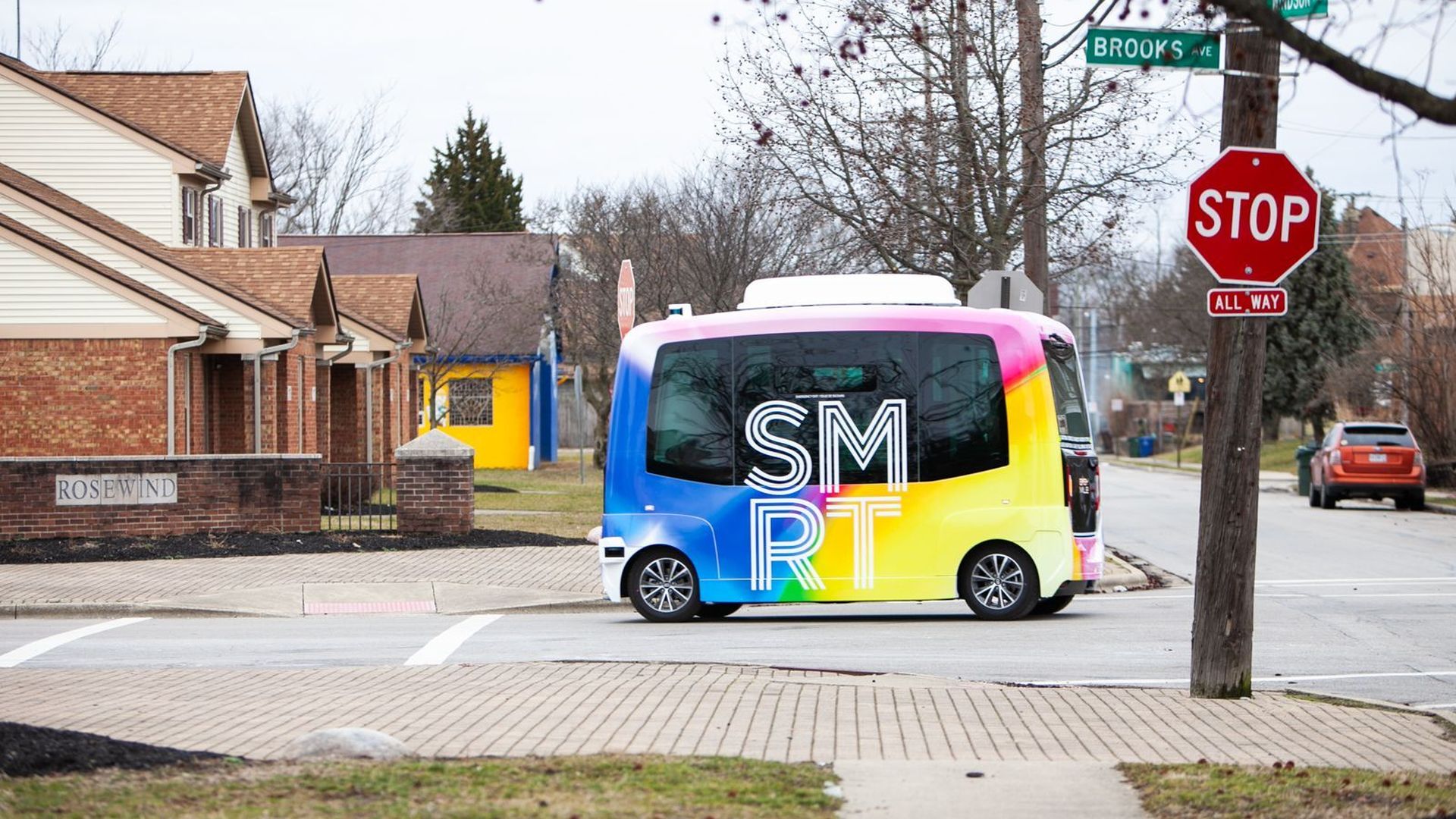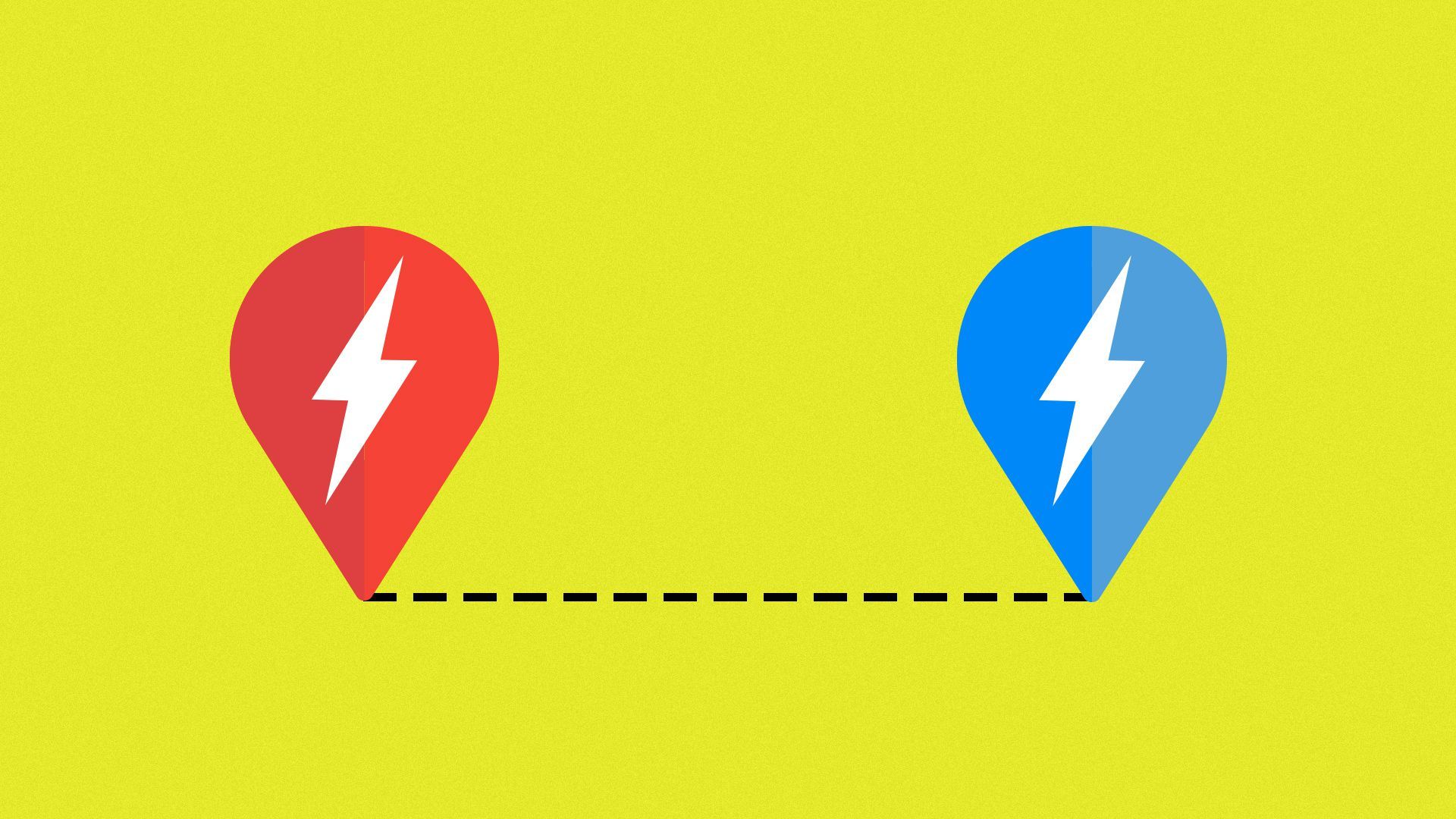| | | | | | | Presented By General Motors | | | | Axios What's Next | | By Bryan Walsh, Erica Pandey and Joann Muller ·Jun 25, 2021 | | We're wrapping up the week with new remote work options, a step forward for electric vehicle charging, radiated astronauts and more. "What was next" trivia: What TV milestone happened on this day in 1951? - Congrats to Jeff Blutstein for the first correct answer to yesterday's trivia question: What island off the east coast of the North American mainland was discovered on this day in 1497 by the explorer John Cabot? Answer: Newfoundland.
- Send your answer, along with tips and feedback, to whatsnext@axios.com.
- Today's newsletter is 1,247 words, a 4.5-minute read.
| | | | | | 1 big thing: The rise of "third workplaces" |  | | | Illustration: Sarah Grillo/Axios | | | | People aren't working from the office, but they're not working from home either, Axios' Erica Pandey reports. The big picture: As the world begins to move past the pandemic but holds onto remote work, we're seeing the rise of "third workplaces" — teleworking spots in cafes, hotels or co-working spaces. By the numbers: About 65% of companies — startups and huge employers alike — want to have a hybrid office after the pandemic, per recent survey data from the commercial real estate firm CBRE provided to Axios. - "But hybrid work is not a binary choice between home or the office," says CBRE's Julie Whelan. "As the majority of large companies are hybrid-focused, these third places are going to be a huge part of work."
What's happening: Alternative work environments are gaining popularity because working from home or the office can be full of distractions. - Parents are juggling work with child care, and apartment dwellers are dodging roommates while they take calls.
- Even if you don't intend to do the dishes or fold the laundry until you're done for the day, just seeing it there can quickly take you out of the work mind-set, says Georgetown professor Cal Newport, author of "Deep Work."
- And at the office, getting approached by colleagues or your manager could derail focus, he says.
"Third workplaces" are popping up all over cities. - Hotels are adding remote work facilities.
- WeWorks allows workers to rent space by the hour.
- It's also a new way for restaurants, many of which are still recovering from the shock of the pandemic, to make extra cash.
Yesterday, I worked from Kindred, a restaurant in New York that doesn't open for diners until 5pm but offers a work-from-home reservation during the day. - For $25, I booked a table in a beautifully decorated and covered outdoor dining area with nearby outlets and high-speed WiFi. And I had access to water and free coffee all day. I'll definitely be back.
The bottom line: Workers all over the world are realizing that working remotely outside of a deadly pandemic doesn't necessarily mean working from your home. Read the rest. |     | | | | | | 2. Smart Columbus' next steps on mobility tech |  | | | The Linden LEAP, Columbus' self-driving shuttle, helped residents in a disadvantaged neighborhood. Photo: Smart Columbus | | | | Columbus, Ohio, was transformed by new mobility technology over the past five years after winning the coveted Smart Cities Challenge, and it plans to keep innovating after completion of the project, Axios' Joann Muller reports. What's happening: Dubbed Smart Columbus, the city says the mobility initiative will continue as "an agile, collaborative innovation lab" focusing on "what is new and next at the intersection of technology and community good." The backstory: In 2016, Columbus won the hotly contested competition among U.S. cities for a $50 million award from the U.S. Department of Transportation and the Paul G. Allen Family Foundation. - Along with another $19 million in state and local funds, the city deployed a broad portfolio of emerging mobility technologies to show how safer, cleaner and more equitable transportation options could benefit communities.
Some examples: - The Linden LEAP, a self-driving shuttle, transported nearly 130,000 meals and 15,000 masks from St. Stephen's Community House to neighbors in need during the pandemic.
- The Pivot multimodal transportation planning app was downloaded more than 1,000 times during the pandemic to help travelers plan and pay for trips combining bus, ride-hailing, carpool, bikes, scooters, taxis and personal vehicles or bikes.
- More than 1,000 connected vehicles could "talk" to each other and to 85 dangerous intersections, which improved emergency response times and slowed speeds in school zones.
- At least 20,000 additional jobs and 3,000 additional health care services were accessible within 30 minutes for travelers originating at the Linden Transit Center in a disadvantaged neighborhood, an analysis showed.
What's next: Five of the eight grant-funded projects — Pivot, ParkColumbus, smart mobility hubs, the connected vehicle environment and the Smart Columbus Operating System — will continue past the term of the grant. Read the rest. |     | | | | | | 3. EV charging providers to allow roaming across their networks |  | | | Illustration: Aïda Amer/Axios | | | | The next step in getting more people to use electric vehicles is to make it easier to charge them anywhere — and now a new partnership among several EV charging companies will allow roaming access across their networks, Joann also reports. Why it matters: Your phone works on any mobile network, no matter which provider you use. And you can use any bank's ATM, regardless of where you keep your money. Now the same will be true of EV charging. The state of play: Currently, most EV drivers can only charge at the stations where they've set up accounts. That means some EV drivers carry a wallet full of swipe cards, fobs or phone apps for different networks along their travel routes. - The big exception is Tesla, which made it easy. Since 2012, all Tesla owners have to do is drive in, plug in to charge and any billing happens on the back end.
- The catch: Tesla's network is proprietary, so owners of other EVs can't use it.
Now the rest of the industry is catching up. The new roaming partnership includes Greenlots, ChargePoint, EV Connect and FLO and covers 54,000 chargers in the U.S. and Canada. Other partners are expected to join later, including EVGo. - Roaming enables EV drivers to find, access and pay for charging across multiple networks through their preferred network's mobile app — without additional sign-ups, fees or markups.
- Carmakers have also set up roaming agreements with many of the same players, allowing customers to find more than 60,000 plugs and handle payments via their branded apps.
What to watch: True interoperability — which is starting, per Car and Driver — allows the charger to automatically identify the car, validate the charge and start the current flowing without any need for key fobs or apps. |     | | | | | | A message from General Motors | | Progress moves when everybody's in | | |  | | | | General Motors is investing $35 billion globally in EVs and AVs through 2025 and providing access to nearly 60,000 places to charge across the U.S. and Canada. Why it's important: By creating a seamless charging experience, GM's investment is electrifying the future. | | | | | | 4. Radiation limits for astronauts get a new look |  | | | Illustration: Aïda Amer/Axios | | | | Want to send people to Mars? You'd better figure out how much radiation you want them to risk — and you should probably do it sooner rather than later. Driving the news: A new report says NASA should update its radiation limits for all astronauts as it considers sending people on long-duration missions to destinations like Mars, Axios' Miriam Kramer reports. Why it matters: Radiation exposure is a major risk for astronauts, who —especially when exposed to high-energy galactic cosmic rays in deep space — can be at increased risk of developing cancer, cognitive issues and cardiovascular problems. What's happening: The new report from the National Academies of Sciences found that NASA's proposal to use a blanket, career-long dose of radiation as its limit for all astronauts regardless of age or gender will allow all astronauts to have an equal opportunity to fly. - At the moment, radiation exposure is considered a higher risk for female astronauts, setting their lifetime allowable doses lower than men, and limiting opportunities to fly.
- By setting the allowable dose at the same amount for everyone, it will level the playing field for everyone, allowing for more flight opportunities for women.
Yes, but: A mission to Mars would likely require the career-long limits on radiation to be exceeded, even at the proposed new standard, according to the report. - The report suggests that NASA will need to ask astronauts to sign a waiver for radiation-related health issues in order to crew these missions ethically.
- NASA should also work to clearly communicate radiation risks to individual astronauts specifically, even with the proposed change to the radiation limits, the report says.
|     | | | | | | 5. 1 digital wallet thing |  | | | Photos: Roger Kisby/Bloomberg via Getty Images | | | | Here's a look at the Resorts World Genting Rewards app digital wallet during a preview of Resorts World Las Vegas on Tuesday. Above, an employee scans a QR code. Below, a closeup of the app. |     | | | | | | A message from General Motors | | Progress moves when everybody's in | | |  | | | | General Motors is investing $35 billion globally in EVs and AVs through 2025 and providing access to nearly 60,000 places to charge across the U.S. and Canada. Why it's important: By creating a seamless charging experience, GM's investment is electrifying the future. | | |  | | The tool and templates you need for more engaging team updates. | | | | | | Axios thanks our partners for supporting our newsletters. If you're interested in advertising, learn more here.
Sponsorship has no influence on editorial content. Axios, 3100 Clarendon Blvd, Suite 1300, Arlington VA 22201 | | | You received this email because you signed up for newsletters from Axios.
Change your preferences or unsubscribe here. | | | Was this email forwarded to you?
Sign up now to get Axios in your inbox. | | | | Follow Axios on social media:    | | | | | |










No comments:
Post a Comment